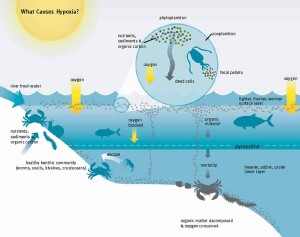By Haley Walker
Walkerh4@msu.edu
Great Lakes Echo
Oct. 12, 2009
Researchers are studying whether Great Lakes fish contaminated by mercury are threatened more by low oxygen in the water than healthy fish.
The International Joint Commission recently recognized runaway plant growth, a cause of low oxygen, as a major Great Lakes problem. The U.S./Canadian commission advises those governments on Great Lakes issues.

Cause of low oxygen in water. Click to enlarge. Source: U.S. Environmental Protection Agency
Low oxygen is called hypoxia, a condition the U.S. Geological Survey says is caused by an increase in nutrients. Nutrients and other contaminants often enter lakes and streams by way of surface runoff. Fertilizer, pesticides, and other chemicals flow from farms and lawns into bodies of water by way of rain and snow.
The added nutrients often cause an increase in algae growth, a process known as eutrophication. When the plants decompose, the bacteria eating the algae uses
the oxygen in the water.
While this problem does not discriminate and can affect all Great Lakes fish, researchers are particularly concerned for those that have also been exposed to mercury.
Mercury most often enters the atmosphere by way of power plants and facilities running on coal. The contaminant then settles into lakes and oceans. While the effects of hypoxia and mercury contamination of fish have been studied separately, until now interactions between the two problems have not been examined, researchers say.
The investigation is checking to see if fish that have been contaminated by mercury will be more affected by hypoxia. “We are interested in the idea that there could be some common mechanism at the cellular level to respond to these two stressors,” Head said. “There might be some parallels between how fish respond to low oxygen and contaminants.”
John Gannon, senior scientist at the International Joint Commission, says that there has been a resurgence in the amount and concentration of algae across the Great Lakes. “The problem was pretty well solved in the 1970s and 1980s, when the two countries spent more than $8 million through the Water Quality Agreement,” Gannon said. “I never thought in my lifetime that I would ever see the algae blooms come back to the extend that it has.”
Dead fish, habitat loss, and ecological changes have all been cited as effects of hypoxia.
“Fish can’t survive under little oxygen conditions and therefore the habitat becomes no longer available for the fish,” Gannon said. “Mobile fish have the ability to escape hypoxic situations, but the food organisms cannot. Food chains can then be disrupted by this loss of habitat.”
Yellow perch, a native Great Lakes fish, was used in the first round of tests conducted for this investigation. “They have great value commercially and recreationally,” said Niladri Basu, co-investigator and assistant professor at University of Michigan’s School of Public Health, said. “All fish in the Great Lakes will have mercury in them, but these can have high levels.”
Proving that a fish has been exposed to hypoxia is difficult. “Mercury is pretty easy to detect, but for hypoxia, there is no way to know,” Head said. “In this study we are also going to try to find some biomarkers, such as molecular or biochemical responses in the fish, where you could detect whether it have been exposed to hypoxia.”
Initial results of the first experiment are expected to be available in December. The team hopes to later apply its research outside the lab. “We want to use the information and then think about the ecological implications,” said Edward Rutherford, a research fishery biologist. “If we determine a marker for hypoxia and mercury, we can see how prevalent it is in nature.”